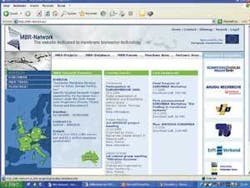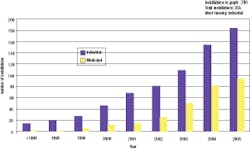EC investment promises further advances in MBR technology
The membrane bioreactor (MBR) technology is considered key to advancing municipal wastewater and reuse schemes given its anticipated market growth rate of more than ten percent per year. A significant research initiative endorsed by the European Commission should increase the development and application pace of the membrane-based process in the municipal wastewater sector.
by Boris Lesjean, TorOve Leiknes
The Lisbon strategy aims to make the European Union “the most competitive and dynamic knowledge-based economy in the world.” Within this context, complemented by the Environmental Technologies Action Plan, the European Commission (EC) planned to consolidate this technological expertise and to accelerate the development and application pace of MBR technology for municipal wastewater treatment in Europe. Therefore, the EC decided to support and finance four projects entirely devoted to research, development, capacity building, and technological transfer in regards to this promising wastewater treatment process.
These projects, which acronyms are AMEDEUS, EUROMBRA, MBR-TRAIN and PURATREAT have been implemented in parallel and will be conducted in the period October 2005 to December 2009. More information on these projects is available on the website: wwww.mbr-network.eu).
Close to 50 European and international companies and institutions are actively involved in these four projects and will join their efforts and coordinate their actions within the cluster MBR-Network. The projects have a total budget of about €16 million, of which almost €9 million will be financed by the European Commission, and thus represent the largest coordinated research initiative on this topic worldwide.
All participants of the MBR-Network cluster will contribute to the development and optimization of MBR technology, and thereby contribute to the implementation of this high-tech process as a common and competitive treatment option for future municipal wastewater treatment applications. Ultimately, the results of these projects will accelerate the technological acceptance of MBR technology and broaden its field of application in Europe.
Fundamental investigation and applied research
The project contents have a mixture of fundamental and applied research approaches that will guarantee technological breakthroughs required to ensure incremental process improvement in all related technological fields that apply to MBR systems; i.e. filtration material and fouling control, module and filtration systems, engineering and process integration, and plant operation.
One significant effort will concern the reduction of operating costs, which present a major bottleneck for the broad application of this technology in the municipal sector. A reduction of the operating costs close to the level of conventional processes would undoubtedly lead to the acceptance of the MBR technology as a state-of-the-art process. Research work conducted by the group of around 30 leading universities and research centers in the MBR field will therefore also focus on strategies to reduce aeration demands, to understand and control inherent fouling mechanisms found in membrane systems, and to optimize membrane chemical cleaning regimes.
Five novel European MBR technologies
The projects will also foster the development and optimization of competitive MBR filtration systems developed in Europe. Five membrane and module producers (KMS, A3 water solution and Inge from Germany, the UK-based company Millenniumpore, and the French company Polymem) aim to develop proprietary products based on innovative and distinct concepts of low-cost and high-performance/low-energy MBR filtration systems. The results are anticipated to increase competition, further reducing the investment and operation costs related to the technology, and thus accelerate its acceptance and application. These technologies will be tested and assessed at commercial scales, in particular by the five end-users (MBR operators), which joined the projects. Some technologies will be implemented in containerized units in order to improve the economy of small-scale systems up to 2,000 pe (integrated MBR units) and up 10,000 pe. (containerized filtration unit only).
MBR standardization
Contrary to other membrane technologies, such as dialysis or reverse osmosis, which went through a worldwide process of standardization, ultimately contributing to a dramatic reduction in production costs, the MBR sector has not taken an initiative for such an evolution so far. This reduces the acceptance and competitiveness of the technology while increasing the risks to be borne by the clients. An organization of the MBR market can be expected, which may lead to a natural identification of few standards as dictated by the market forces. However, a proactive approach between market stakeholders may accelerate this phenomenon of standardization and identify normalization criteria for module design and characterization methods in the most efficient way, that are acceptable to the entire market sector.
Aquafin and Veolia Water, two major companies versed with the construction and operation of MBR plants, have undertaken, in liaison with the European Committee for Standardisation, an analysis of the market interests, industrial potential, and technical possibility of MBR standardization in Europe in terms of filtration systems and characterization methods. They have contacted and surveyed more than 80 representative market players and, after extended consultations with the industry, will provide their recommendations in a White Paper on MBR standardisation by early 2007. The standardization, or partial standardization, of the MBR technology in Europe will benefit the entire MBR sector as it will ultimately increase the acceptance and implementation of this technology.
More know-how for MBR system integrators and operators
The success of MBR plants lays at the crossroad between efficient filtration systems and appropriate/optimized design and operation of the entire membrane activated sludge plants. This expertise is one of the strengths of the European MBR industry, which includes global players such as Veolia Water applying their know-how in many countries. This aspect is crucial knowing that the process integrator and/or operator will carry the risk of the commercial project in most cases. An improved knowledge and control of the technological risks inherent to the technology at the design and operation stages will further reduce the life cycle costs of the commercial schemes. The research and development projects will therefore carry decisive studies to improve design and operation practices. Investigations will be performed in relation to the pre-treatment, the flow pattern (problematic of the flow peak in membrane systems and the load peak into the biology), the modelling of the biological or the filtration step, the use of advanced control systems, and last but not least, the best practices for plant upgrade or extension with the MBR technology. The improvement of the design and operation practices, allied with the sound selection of appropriate design and operation criteria depending on the frame conditions (plant size, type of effluent to be treated, existing infrastructure, environment, etc) will further improve the competitiveness of MBR technology.
Capacity building and technology transfer
These projects pay special attention to capacity building and technology transfer. European competitiveness will depend upon the level of education and training of its professional elite; hence the projects will host numerous young researchers and engineers and train a significant pool of experts and managers for tomorrow’s projects to further build up leading edge expertise on MBR technology in Europe.
Technology transfer will be organized towards future European markets (EU accession countries, and Mediterranean and Middle East countries) in order to facilitate the penetration of the technology in these countries, but also towards other countries involved in the MBR-Network, including Australia and South Africa. This should contribute to the export of European know-how and technologies into these regions with high market potentials with regard to wastewater reuse and reclamation for which MBR technology is well suited.
Bright future
The MBR-Network is expected to achieve significant technological breakthroughs. While improving current process engineering and operation practices, it will also improve the competitiveness of the European MBR market and render common this high-tech process for municipal wastewater treatment. The first results of the projects will be presented in May 2007 at the Membrane Technology Conference of the International Water Association in Harrogate, United Kingdom. The conference program for this event is available at: http://www.iwamembranes.info.
Authors’ Note
Boris Lesjean is leader of the membrane technology program at the Berlin Centre of Competence for Water and coordinates AMEDEUS. TorOve Leiknes is associate professor at the Department of Hydraulic and Environmental Engineering of the Norwegian University of Science and Technology, who coordinates EUROMBRA.
MBR-Network website for international MBR community
The Berlin Centre of Competence for Water edits the online website http://www.mbr-network.eu, which provides detailed information on European projects devoted to MBR technology, such as research programs, participants, and events. Additionally, it is intended and designed as a communication and exchange platform dedicated to the worldwide MBR-community. It offers contacts to a large group of international MBR professionals and experts; not all are directly involved in European research consortia. The following free services are offered online:
- Database of companies and institutions active in the MBR field (already more than 70 companies included);
- Database of articles, books and conference proceedings related to MBR (more than 350 references);
- Database of other European projects involved with MBR (about 30 EU projects listed);
- List of international conferences, symposiums or seminars addressing the MBR topic (30 referred events so far);
- Web-based discussion forum between members of the MBR-community.
Companies, institutions, or persons interested by or active in the field of MBR technology are invited to register online and to provide relevant news or information to the MBR community through this website. After six months of existence, about 250 international MBR specialists or professionals are already registered to the MBR-Network!



